Web3 Mobile Review Can the encryption industry usher in an iPhone moment?
Web3 Mobile Review Can Encryption Industry Have an iPhone Moment?
Author: Jason | Puzzle Ventures (@0xjasonliu)
Good web3 researchers are those who can evaluate phones.
As a web3 researcher who hasn’t fully understood on-chain data yet, I never thought that one day I would have to evaluate phones. The concept of web3 phones is similar to the concept of handheld computers in the past. It seems that phones and web3 are a perfect match, but it also seems a bit strange. To put it simply, it is a groundbreaking product that combines the internet with mobile internet. To put it in a more specific way, it is an ordinary phone with some web3 software and hardware added. In today’s world where web3 has not been fully accepted, web3 phones add more possibilities to web3, as well as uncertainties.
- Another example of a flash loan attack, analysis of the LianGuailmswap security incident
- Comparative Study Differences and Similarities between ANS and ENS
- No worries about secure cross-chain transactions? Understanding the xERC20 cross-chain token standard in one article.
Regardless, any new thing is born amidst criticism, grows amidst doubt, and becomes indispensable when nobody can live without it. So, why not study the full picture of web3 phones rigorously and carefully? What if it becomes a historical turning point for mass adoption? Okay, as usual, let’s start our study from the earliest web3 phones. Wait, the earliest web3 phone is actually the Metavertu released by Vertu, a dying old money factory? Well, web3 is a world of wonders and quirks. Just get used to it. However, to enhance the rigor of our research, it is necessary for us to first clarify the panorama of the web3 phone market, and then… continue.
Overview of the Web3 Phone Market
The web3 phone market is a typical emerging market characterized by lack of unified standards, chaotic prices, non-mainstream manufacturers, and inconsistent user experiences. However, by comparing various phones horizontally, we can still observe some clues.
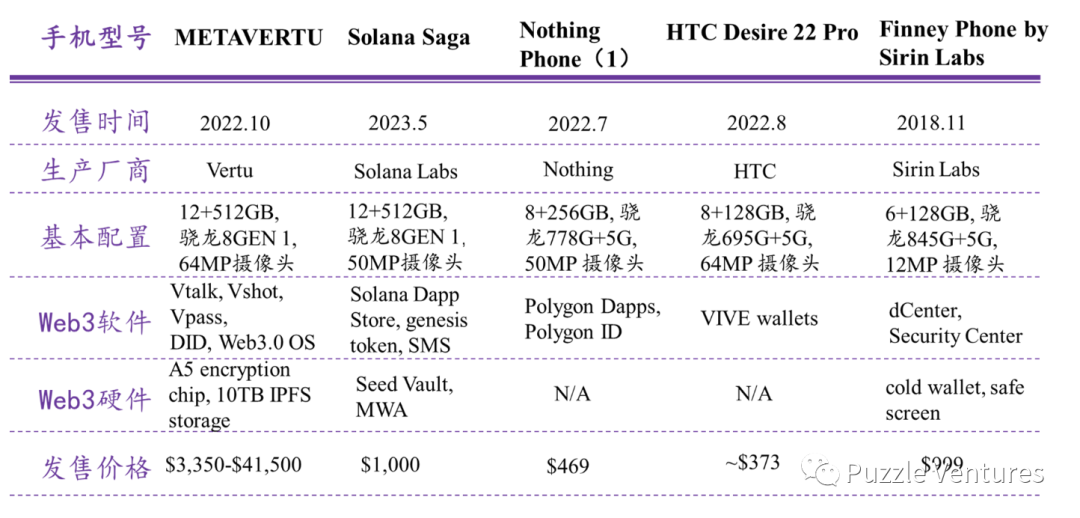
Figure 1
As shown in Figure 1, there are currently 5 main web3 phones, and only the first three can truly meet the basic requirements of being web3 native. Therefore, it is difficult to summarize any regular development trends at this stage. Regardless, we still need to analyze the underlying development logic from some less obvious trends:
1. Manufacturers tend to be non-mainstream. This is not difficult to understand, as web3 phones are products with high uncertainty. Major phone manufacturers have standardized research and development plans and production requirements, and it is unlikely for them to quickly enter the market because of the new concept of web3 + phones. At the same time, major phone manufacturers are still competing in the software ecosystem, and from the perspective of web3 phone software, it would be self-defeating for them to adopt web3 OS, dapp Store, and DID, which would disrupt their own ecosystem. From the perspective of investment return, it is completely illogical. On the other hand, web3 phones themselves are a combination of wonders, and they align with the differentiated routes of small and medium-sized manufacturers, so it is not ruled out that web3 phones may form a bottom-up reverse growth trend in the future.
2. The basic configuration of web3 phones is at an above-average level. This is not difficult to understand. The concept that web3 phones emphasize is the integration of web3, rather than competition in terms of configuration. Even if some mobile phone functions are added to cold wallets, I believe it will still be a fresh product. Of course, the two leading phones, METAVERTU and Solana Saga, adopt processors that are close to top-level configurations in current Android phones, along with relatively strong camera and storage capabilities, which can reach the level of first-tier phones. The remaining few companies have varying configurations, similar to assembling a basic configuration that meets the middle level. However, to be honest, any user who pursues configuration is unlikely to buy any web3 phone, and web3 degens should at least have a commonly used main machine. Therefore, the configuration of web3 phones is basically “tasteless but a pity to give up”.
3. The software layer of web3 phones focuses on dapp store, wallets, and DID. This involves a very important question: the technological development path of web3 phones, whether it is the integration of the software layer, such as OS+dapp store, or major hardware changes at the hardware layer, such as cold wallets+Blockchain SIM cards. We will discuss this question in later articles. Purely from the software layer perspective, the currently popular web3 integration approach is to embed dapp stores or curated dapps to enhance dapp accessibility, and then use wallets and DiD to build relatively private and secure operating environments. Furthermore, some identity verification functions such as using mobile phone cameras, fingerprint recognition, and face recognition are added, and finally, some welfare gameplay such as NFT airdrops are added. In addition, Solana Saga has developed a Solana Mobile Stack that is convenient for developing web3 dapps, providing some toolkits for developing dapps in the Android environment. The true value of this web3 combination needs to be judged based on actual user experience, and also considering the ultimate question: Is it better for any phone to install a universal web3 OS or adopt a pre-set single-ecosystem web3 system?
4. Each web3 phone has its own hardware advantages. METAVERTU adopts a dual-chip mode to enhance the security of the execution environment, that is, an additional Qualcomm A5-level security chip is added. The specific working principle is: establish an isolated environment separate from the main chip based on TEE (Trusted Execution Environment) + SE (Secure Element), and at the same time, interact with the original system through APIs, similar to the bank-level security hardware ancestor – U shield. This dual-chip security solution is obviously costly, and the specific practical effect remains to be verified. Looking at Solana Seed Vault, it is essentially a combination of software and hardware, where encrypted information is stored in a secure environment within local hardware. On the other hand, the early Finney Phone simply added a complete set of hardware wallets and used a physically encrypted safe screen (similar to a sliding cover unlock) for additional protection, but it seems to have received little attention at present. Overall, there is room for integration in the hardware aspect of web3 phones. Innovative hardware security solutions, such as the bsim card released by China Telecom recently (which stores private keys in the SIM card), can better demonstrate the value of phones as physical hardware connected to the digital world than software.
5. The price of Web3 phones currently does not have a standard. Looking at the exaggerated price range from $3350 (Metavertu minimum configuration) to $376, the current market positioning of Web3 phones is still in a state of confusion. From the horizontal comparison of price gradients, there are currently at least three types of positioning for Web3 phones: high-end cool phones, Web3 expert backup phones, and grassroots non-mainstream phones. From a relatively rigorous perspective, we need to determine whether the future main application scenario of Web3 phones is as a main phone or a backup phone. As for the main phone positioning, Solana Saga is the closest, but from several public practice evaluations, Solana Saga does not meet the standards of a top-tier main phone in terms of UI smoothness and configuration richness. As for the backup phone positioning, Solana Saga and several other low-priced Web3 phones seem to be satisfactory, but is the original intention of the emergence of Web3 phones to become a backup phone? At the same time, the single Solana and Polygon ecosystems as backup phones cannot fully meet the basic needs of Web3 experts. Therefore, the positioning of Web3 phones in the future has only two paths: gradually grow into a phone that can meet the basic general needs of Web3, and approach the level of a main phone; or gradually become a niche, grassroots, or even obsolete product.
Through the above analysis, we found that the current issues that Web3 phones need to address are: first, the solution of reasonable hardware and software matching and optimization; second, the handling of competition and cooperation between phone manufacturers; and third, a clearer positioning between main phones and backup phones.
Technical Path of Web3 Phones
The technical path of Web3 phones mainly involves three areas: hardware, OS software, and Dapp software. The combination of Web3 hardware wallets and phones can form a “hardware + hardware” solution, while Web3 OS and Dapps can interact with the chain (including wallet encryption) through light nodes or third-party nodes, and achieve the purpose of running Web3 on the phone.
✦Hardware path of Web3 phones
From the current attempts of Web3 phone hardware, they can be roughly divided into the first-generation solution of hardware wallets + phones that appeared around 2018, and the second-generation solution of SIM cards + phones and chips + phones that appeared around 2022 (in fact, hardware wallets are also chips), as shown in Figure 2.
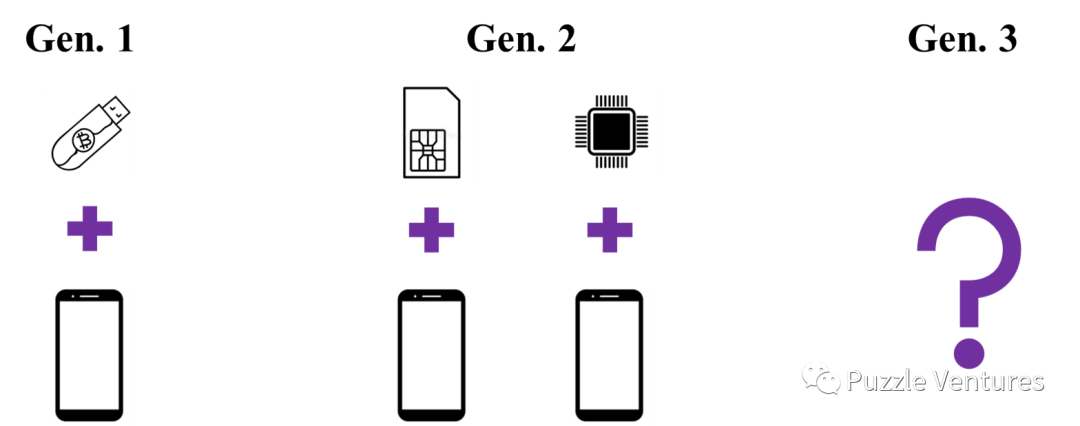
Figure 2
Let’s start with the first generation solution. The HTC Exodus 1 and Finney Phone launched web3 phones with built-in hardware wallets and some simple operating software at the end of 2018. If I remember correctly, the end of 2018 was the bottom of the previous bear market. From this release timing, we can roughly feel the lack of professionalism in the understanding of Web3 by these two manufacturers, and their phone sales did not create any waves.
Looking at the promotional materials of the HTC Exodus 1 at that time, the device was preloaded with a set of management hardware wallet (chip) called Zion App to achieve similar functions of private key storage, payment, and remittance of ERC-20 and ERC-721 tokens as ordinary hardware wallets. It also comes preloaded with basic software such as Brave browser and market software, completing the so-called web3 phone solution. On the other hand, Finney Phone is relatively more innovative, with an additional SafeScreen component, as shown in Figure 3. This means that when you need to use the hardware wallet, you need to physically move the safe screen, so that the phone will disconnect from the external network and the operations within the wallet will be in a secure environment.

Figure 3
This retro design reminds me of the physical keyboard of BlackBerry, which, although it is practical and simplistically solves some problems, cannot resist the trend of technology. Web3 phones are the same. Although the first-generation solution provides a basic solution, it faces serious challenges from the trend of retro design, incompatibility with existing systems, smoothness of UI, etc.
Now let’s look at the second-generation solution. METAVERTU adopts the TEE+SE secure environment implemented by another independent chip and OS switching. The BSIM+phone solution launched by China Telecom and Conflux, which is mainly based on blockchain sim cards (BSIM), is also an alternative hardware technology path.
The TEE+SE independent chip trusted execution environment technology adopted by METAVERTU is relatively reliable. TEE technology has formed standards and specifications since the 1990s. It is a hardware execution environment that can only be accessed through a private key, and records the hash state before and after the execution to ensure that there are no problems during the execution or there is evidence to follow in case of problems. At the same time, the data in the environment is additionally encrypted by SE, so even if the operating system is exploited, it can still provide the last layer of protection for the data in the environment. Therefore, under the premise that the information before entering the execution environment is not incorrect, the execution process is relatively secure, similar to a hardware wallet. However, this technology still has two problems: First, the cost is too high. The computing power and storage space required by the execution environment determine the requirements for chip grade. Chips like METAVERTU’s Snapdragon chip will raise the price to over $3000 (although there are also brand premiums), which is extremely unfavorable for mass adoption. Second, this TEE approach is more suitable for security protection in relatively closed systems such as banks. If you need to connect the entire web3, especially in scenarios involving MPC and Oracles that require a large amount of data interaction with the outside world, more complete privacy computing and customized smart contract-related infrastructure are needed to ensure efficiency, privacy, security, and scalability in the process of data transmission from outside to inside and from inside to outside.
The basic principle of BSIM card is to increase the storage space and computing power of SIM card by ten times, to generate and store the public and private keys of users in the card. According to the official explanation, “BSIM card can reduce the risk of malicious software attacks by adopting hardware security protection technology, and can also bind digital identity and real identity through mobile phone number real-name system. In addition to basic private key management and digital signature, BSIM card can also achieve operations such as encrypted storage and key recovery, and even integrate traditional U shield function in the card.” Aren’t these functions exactly the basic functions solved by hardware wallets? In other words, BSIM card basically provides the ability to run wallets and DIDs on mobile phones in web3. Samsung once cooperated with Ledger to develop the Ledger Live APP to connect Ledger to mobile phones through Bluetooth, thus realizing the ability of web2+web3. When BSIM card becomes a more popular paradigm in the future, it is obviously a more attractive and imaginative solution to realize the ability of web2+web3 with a single mobile phone.
It is worth mentioning that when I was searching for relevant materials about BSIM, at least 50% of the information was discussing the development potential of BSIM in Africa, which is unexpected and reasonable at the same time. First of all, BSIM card effectively solves the problem of confusion in Africa’s banking system and fiat currency system. Compared with the development of Alipay and LianGuaiyLianGuail in a well-established financial system, Africa’s own imperfect financial system has brought about a good soil for web3 payment. According to World Bank data, as of 2021, only 53% of adults over the age of 15 in sub-Saharan Africa have a bank account or mobile payment software based on a bank account. Therefore, when BSIM card provides web3 infrastructure + cryptocurrency as payment equivalent + individual on-chain KYC + mobile payment based on mobile phones to form a complete chain, the enormous potential of mass adoption of web3 among young people in Africa can be imagined.
✦OS & dapp path of web3 mobile
The OS or dapp path of web3 mobile is actually very easy to understand. Web3 OS is to establish a separate decentralized (mobile) operating system with a light node to achieve on-chain interaction throughout the system, while mobile Dapp is to achieve on-chain interaction through the built-in interaction facilities of centralized mobile OS. This topic is very broad, from web3 browsers to in-app stores in web3 wallets, to complete web3 mobile OS, all can be understood as a solution. Therefore, in this simplified discussion, the author only discusses the pure web3 mobile OS.
Currently, the more pure web3 mobile operating systems include ethOS, Conflux OS, dappOS, and other separate products. Near, Polkadot, and others are also developing operating systems based on their own chain ecosystems. These OS systems are all trying to establish a set of unified interfaces for the application layer, improve interaction efficiency through light nodes, and provide better developer tools, thus laying the foundation for potential mobile web3 in the future. But is the reality really as beautiful as we think?
First, let’s discuss the necessity of web3 mobile operating systems. Through a comparative analysis of different existing OS, the author believes that the current value of web3 OS is mainly to provide unified identity and wallet interfaces, unified scheduling of mobile hardware, and improve user experience. As shown in Figure 4, the innermost layer of the METAVERTU web3 OS demonstration diagram is the unified authentication and protection of personal identity, which then evolves into different functions in the outer circle. Without using web3 OS, if you want to perform actions on more than two dapps on a mobile phone, you need to repeatedly switch between different dapps and send data between different RPCs. The experience is certainly not as smooth as the operations within web3 OS. However, web3 OS itself also has certain problems: independent OS requires strong technical personnel to continuously maintain it, the efficiency of technical and version updates is questionable, and even security risks may arise; web3 browsers, wallets, and other alternatives can achieve similar functions, but the trade-off between user experience and security cannot be fully verified.
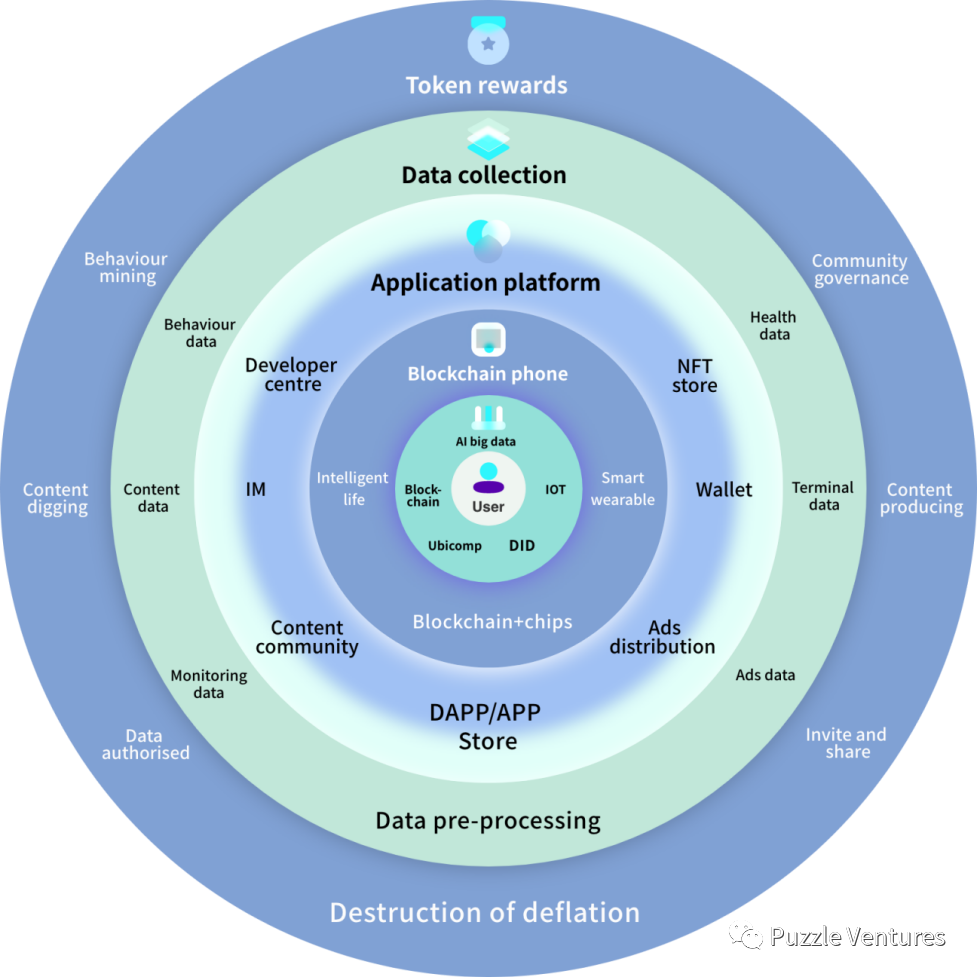
Figure 4
On the other hand, let’s talk about security. Using mobile dapps in an open-source environment like Android OS is definitely the least secure, so is web3 OS necessarily more secure? The reason why hardware wallets are secure is because they are not connected to the internet throughout the process and operate through fully enclosed built-in software, making them immune to hackers and network attacks. Although some web3 OS also have the ability to combine software and hardware for key physical storage with the help of mobile chips, the web3 OS system itself still has the possibility of being attacked. However, I believe that the developers of web3 OS will take targeted security measures. From the perspective of user experience, do users really care so much about security, whether it’s 80 points or 90 points? Is the 90-point security provided by web3 OS the only factor that prompts users to give up their original 80-point security environment? No, what users really care about is whether it’s good to use, fun, and whether they can make money. So the real task for web3 OS is still to improve the richness of the dapp store, the usability of multi-chain interaction, and the optimization of gas fee reduction and other costs. As for security, including data privacy, it can only be said to be an icing on the cake.
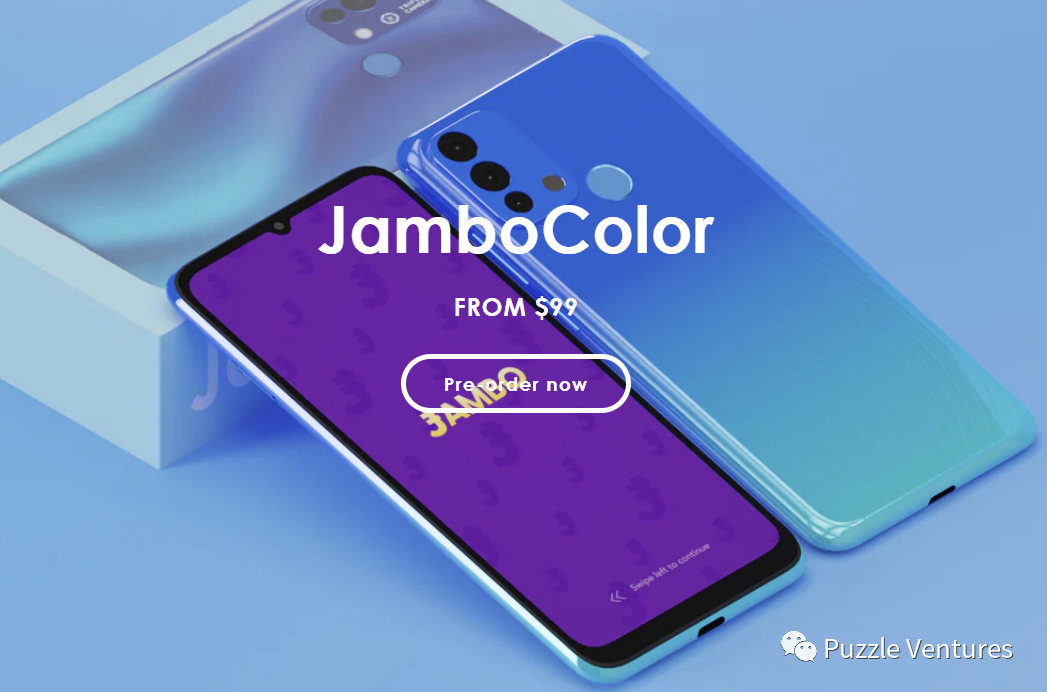
Figure 5
JAMBO knows it well. JAMBO is a web3 superapp targeting the African market, and its recently launched JamboColor is also a web3 phone (Figure 5). From the current promotional materials, we have learned several pieces of information: it is priced at a minimum of only $99, comes with a wired phone, has a fashionable appearance, and the built-in JAMBO superapp allows users to watch to earn, play to earn, learn to earn, chat to earn, but it does not mention anything about security or operating system. I believe this will be a very effective attempt at mass adoption because it truly considers what users want, rather than how to boast. Web3 technology iteration is undoubtedly important, but that is a top-down matter, something that Ethereum core members and A16z need to consider. Ordinary users only need a good user experience to appreciate the charm of web3.
User Experience & Community Feedback
An important part of mobile phone reviews is user experience, and the quality of web3 products also partly depends on community feedback. Therefore, we need a section that combines user experience and community feedback to explore these web3 phones in their “naked” state after stripping away the glamorous brochures.
Let’s start with METAVERTU. Due to the dual-chip design, METAVERTU can achieve completely isolated dual-system operation. That means users can enter a new system homepage through the Meta SLianGuaice app and engage in on-chain interactions including cloud storage (IPFS), wallet, browser, etc. Users can also download new dapps from the built-in dapp store. Overall, this set of experience can be considered smooth. However, the current dapp store ecosystem is not sound, so many dapps’ download sources actually lead to external links. Additionally, because Vertu’s own Life Account requires certain personal information binding to use the system, the so-called privacy and external data cannot be protected.
In terms of community feedback, I mainly referred to evaluations on Amazon and Taobao (Vertu has been acquired by a Hong Kong company and focuses on the Chinese market), as well as comments on Twitter and Reddit. First of all, there is a premise that users who purchase such high-priced phones are less inclined to complain about real pain points online. Therefore, I can only form a general perception. From the reviews on e-commerce websites, most of the complaints are about the Vertu system itself, such as battery life, smoothness of Vertu OS, heating issues, etc., and the only few pieces of feedback on web3 usage are positive. Overall, due to the novelty of web3 phones, users have a perceived bonus for new experiences and are not likely to complain too much. As for security and privacy, perhaps no one cares too much until something goes wrong. Today’s mobile phone market is no longer just about hardware stacking, and the competition generated by software capabilities is growing. However, luxury web3 oddity phones like METAVERTU have a bunch of software problems, but they gain reasonable and even additional explanations from the web3 perspective due to the dual-chip hardware stacking. Regardless, borrowing the words of a Reddit username, people who will actually buy METAVERTU are either ultra-rich or ultra-stupid, and future web3 phones should not take METAVERTU as a milestone for development.
Next is Solana Saga. Currently, there have been many reviews in Chinese and English about Solana Saga. Here, I will only provide a simple summary and discuss some trend-oriented viewpoints. The first viewpoint is that Solana Saga has an overall tone of “weak hardware, mixed web3 experience.” The criticism regarding hardware mainly focuses on aspects such as the camera, lack of facial recognition, absence of rear fingerprint entry, screen display effects, battery life, chip quality, etc. Some users even commented that the actual value of the phone is roughly around 3000 yuan. As for the web3 experience, the overall UI and software have received mixed reviews, but the new experience factor still makes it impressive. The most praised feature is the Seed Vault product, which essentially stores important information on a chip processor outside the Android system. It can be understood as a trusted UI that combines hardware and software. After the storage is complete, users can verify transactions through a quick fingerprint authentication method.
The most criticized aspects are the adaptability of web3 software and the scarcity of the dapp store, similar to METAVERU. In terms of adaptability, the current Solana Saga only supports Phantom, Solflare, and Ultimate, which limits the use of some other ecosystem dapps, including Bitcoin (of course, users can still use web versions or other dapps within the Android system). At the same time, different review articles have mentioned issues such as wallet connection failure or crashes in different scenarios, as well as functionality gaps in dapps, confusion in connecting Google accounts and web3 accounts, and other adaptability problems. In this regard, I believe it is not the fault of Solana Saga, but Solana Saga’s SMS is promoting more developers to improve the web3 mobile ecosystem. In terms of the dapp store ecosystem, as of June 2023, the dapp store only provides 30 dapps, and most of them are non-mainstream dapps (as shown in Figure 6). Even the wallet download directory includes Ledger Live. Imagine the future web3 mobile scene: users holding a Ledger wallet and Solana Saga, switching currencies and passwords between different devices, and finally completing an NFT purchase. Is this what Web3 is all about?
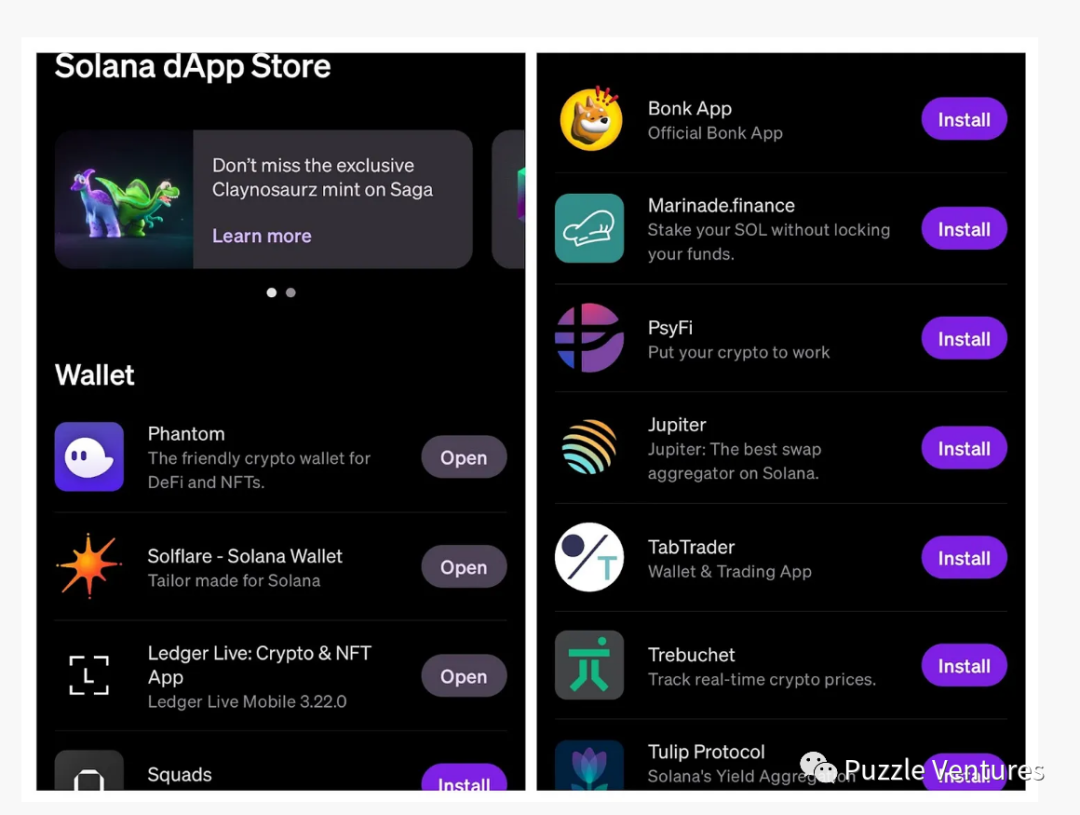
Figure 6
Now let’s take a look at a few relatively niche products, such as Nothing Phone and HTC. Nothing Phone focuses on design and UX, and it is already a unique presence in the mobile phone market, with a cool appearance. In terms of web3, the unconventional Nothing Phone chose to cooperate with Polygon and develop some widgets such as PolygonID, NFTwidgets, and wallets, and airdrop a Black Dots NFT to the community. These actions seem more like marketing activities rather than a complete web3 mobile phone experience. However, this approach is actually a good attempt for phone manufacturers to enhance the charm of their phones through web3 widgets, promote marketing through NFT airdrops, and at the same time, not affect the web2 experience of the phone itself. It can be said to be an icing on the cake.
However, HTC Desire 22 pro is a relatively unsuccessful attempt. First of all, HTC Desire 22 pro adopts a self-built web3 integration solution, which is a set of metaverse components in the Android system, including VIVE wallet, VIVERSE, etc. In fact, HTC not only built a wallet, but also built a metaverse platform, which has violated the original intention of web3 decentralization. From the experience of VIVE wallet, it is just equivalent to a low-end version of a general crypto wallet, supporting only a few ERC-20 tokens and not providing any further development options, which is a regression version of web3 experience. Secondly, HTC Desire 22 pro, as a low-cost device, lacks the functions of chip storage and security environment that a web3 phone should have. It can almost only be considered as a product for the ultra-stupid only group.

Table 1
Summary
The topic of web3 phones is too big and new. Although it is impossible to cover all the information, we still want to make a small contribution to the better future of web3 through constructive summaries. The core question we focus on is: what kind of web3 phone is in line with future development trends? The following are a few points summarized:
1. Web3 phones need to move towards a combination of software and hardware. The hardware-based security environment is the inherent advantage of phones, and the combination of software and hardware processing is the key to improving user experience. The existing web3 phones are strong in hardware or have good UI, but the development direction of the next generation of web3 phones will inevitably be products that are both strong in hardware and have good UI. I believe that it is only a matter of time to create web3 phones that take into account various aspects through careful polishing and improvement of web3 cognition.
2. Web3 phones need to move towards universality. The current web3 phones all have some degree of closed-ecosystem self-isolation problems, and only the universality of multi-chain interaction can truly enrich the dapp store and developers of web3 phones. At the same time, the relationship between the web3 ecosystem of phones and the native ecosystem of phones should be considered. They can be parallel, additional, or overlapping relationships. No matter which direction is taken, the universality of the web3 phone ecosystem needs to be ensured in order to generate the necessary demand for web3 phones from users.
3. Web3 phones need to move towards mass adoption. High prices and niche brands are not choices for mass adoption, and the mass adoption of phones should not be constrained by objective factors such as price and brand. Web3 phones should not become bizarre and niche products (at least not in the future). JamboPhone is actually a good example. Starting from the two most essential demands of low price and good dapps, it gradually iterates from the bottom up, disregarding the concepts of so-called dual chips and security environment.
Disclaimer: This research report is the author’s independent opinion based on the analysis of publicly available information. It is provided for reference and communication purposes only and does not constitute financial, investment, or any other advice.
We will continue to update Blocking; if you have any questions or suggestions, please contact us!
Was this article helpful?
93 out of 132 found this helpful
Related articles
- UniswapX Opening the Gateway to Uniswap V4 DeFi Experimental Base
- Twitter renamed X, Musk ignites the X universe! From AI to exploring space, the prototype of a universal app emerges.
- Tokyo and Kyoto, the rising encrypted ‘twin stars
- a16z In-Depth Analysis What New Gameplays Will AI Create?
- Another animal coin gains popularity, this time it’s the real version of the on-chain hamster race Hamsters.gg.
- LianGuai Daily | Google Cloud is planning more Web3-centered products; Celsius reaches a key settlement, customers may receive compensation by the end of this year.
- Former CEO of stablecoin TUSD sues the company, claiming to have been ousted during negotiations for acquisition by Tron.




